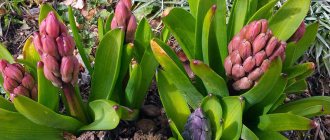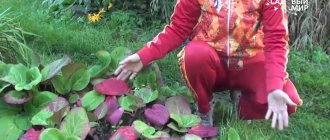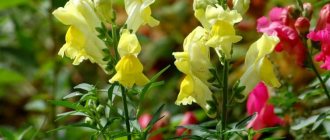The flowering plant, Ipomoea, is the most numerous genus in the elderberry family. There are more than 500 species in this genus. They are found naturally in various regions with subtropical or tropical climates. Morning glory is represented by trees, shrubs and vines, which can be perennial or annual. Among the various species of the genus there are also food species such as water spinach and yam.
The genus name comes from two Greek words: "ips" meaning "worm" and "homoios" meaning "similar", resulting in "worm-like", a term associated with the rhizome of the perennial species ipomea. Flower growers grow vines belonging to this genus; their flowers open early in the morning, when all other flowers are still closed, which is why morning glory is called the “flower of dawn.” Interestingly, fieldweed and morning glory are close relatives.
Features of morning glory
Grown in gardens in mid-latitudes, morning glory is a garden variety, vine that grows up to 5 m in length. The heart-shaped stems are densely covered with hairs. The large flowers are very fragrant and have long stems. The stems are densely covered with flowers that open early in the morning and twist in the sun. They close at noon, but if the day is cloudy, this may not happen until the evening. Double or regular flowers are shaped like a gramophone trumpet and can be colored in various colors such as red, blue, white, pink, etc. Flowering begins in the first weeks of summer and ends with the arrival of frost. In nature it is a perennial, but in mid-latitudes it is grown as an annual.
Decorative properties
The ability of morning glory bindweed to grow rapidly is simply amazing. In just 2 weeks, the plant is able to “drape” a facade wall or a decent-sized veranda. When growing in the garden, you can use morning glory to divide the area into zones, create a hedge, a flowering canopy or a stunningly beautiful porch of the house.
By planting morning glory on your apartment balcony you can create a living curtain. By planting plants in floor pots, you can move them around, constantly changing the appearance of the balcony. Curly morning glory can hide imperfections in the decoration of a balcony. Without the need for trimming and shaping, it is capable of wrapping any vertical shape. This plant is an excellent choice for lovers of ornamental plants.
Growing morning glory from seeds
Sowing
Reproduction of morning gloria occurs in a generative way. The seeds of this plant germinate within 3-4 years. They are sown for seedlings in mid-May, but before sowing they should be scarified (break the integrity of the shell), and instead can be placed in warm water (25 to 30 degrees) to swell for 24 hours. If the seeds do not swell, poke them with a needle and soak again.
Please note that each species requires a specific soil mixture, and this is the main difficulty in growing morning glory. To sow African species, use a succulent potting mix with small clay pebbles added. To sow seeds of American varieties, use a medium consisting of peat, coconut fiber, humus leaves, vermiculite and fine expanded clay (2:2:4:2:1).
Fill small cups with a suitable growing medium, then place 2-4 seeds in each and cover the top of the containers with cling film or glass, creating a mini outdoor house of sorts. Water the seeds as needed, organize regular ventilation, remove condensation from the shelter and maintain the air temperature at 18-20 degrees. If everything is done correctly, the first shoots should appear in 10-12 days.
Seedling care
When the seedlings reach a height of 15 centimeters, a string should be tied to their base, the other end of which should be pulled up and fixed in this position. This will provide support for the seedlings. As the seedlings grow, transplant them 1-2 times into a larger container using the transfer method, but be careful not to expose or damage the root system. Pruning plants will ensure more side shoots form.
Nasturtium
This flower is universal; it can spread along the ground or grow upward. Loves nutritious soil, prefers sun and moderate watering, but is not resistant to cold. A day before planting, the seeds can be soaked in water (hot up to 50 degrees and until cool). In addition, flowers can be used in cooking, decorating salads and desserts with them. The plant needs to be fed 3-4 times a month. It should be borne in mind that if the nasturtium does not have enough nutrition, then its stems quickly become bare, the leaves become smaller, and the plant dies; however, it is also not worth filling the flower with water, the roots may simply rot. To avoid damaging the plant, water it with warm water.
Planting morning glory in open ground
What time to plant
Ripe willow seedlings should be planted in the ground at the end of May or at the beginning of June. This should be done when the soil has warmed up well and the threat of a return of spring frosts has passed.
Rules for planting seedlings
Use the method of transplanting young plants into open ground. A distance of 20 cm should be maintained between the bushes. After planting, install supports over the seedlings, for example, fishing line or netting for branches.
Seeds can also be sown directly into the ground. Sow in late May, after the danger of frost has passed. Choose a windless and well-lit place for planting. The vine grows best in slightly acidic, well-drained soil.
When growing this plant, remember that all parts contain large amounts of poison. Therefore, it should only be grown outdoors.
Description of the plant
Morning glory is native to South and Central America. The flower is also found in its natural habitat in the region of Eastern India. In Europe it is grown in home gardens, on terraces and balconies. Due to its curly nature, it works well as a natural sun protection. Morning glory decorates stone walls, fences, gazebos and pergolas. Plants have creeping, light-weight stems, up to 3-4 meters long.
The most important feature of a vine is its rapid growth. This annual plant blooms almost throughout the summer season. The glass-shaped flowers open late in the evening and close when intense sunlight begins to fall on them. The flowers are funnel-shaped, 8-9 cm in diameter, grow on long stems, and are pollinated mainly by bumblebees and hawk moths.
The flowering date depends on the planting time:
- when sowing seeds in open ground - end of June;
- when sowing for seedlings, the start of flowering is closer to 3 weeks.
The plant is shallow-rooted and has a non-lignified, flexible stem that wraps clockwise around supports. The liana reaches a length of 4 meters. It is important to create reliable support in advance.
Large, green, heart-shaped leaves are attached to the stem on a long petiole, the length of the petiole often matching the length of the leaf.
The fruit is an almost round three-chamber capsule filled with large, black, angular seeds. The seed pods turn dark brown to brown in color and crack when they reach maturity. The fruits are a distinctive feature of different types of morning glory. For example, purple morning glory has a smooth, three-chambered fruit, while other species have a two-chambered or pubescent fruit.
Morning glory care
Watering
Willow should be watered regularly, but in moderation. Do not allow liquid to accumulate in the root system of the plant. In May and August, water these flowers regularly; there is no need to wait until the top layer of soil dries out.
Feeding
Fertilize the vines during intensive growth every 15-20 days. Use cactus fertilizer or flowering plant fertilizer. However, remember that overfeeding, especially with nitrogen fertilizers, will have a positive effect on leaf growth, but a very negative effect on flowering. Therefore, apply as little fertilizer as possible. The concentration of fertilizers should be the same as for home flowers.
Trimming
Sometimes pruning is necessary. For example, it is necessary to cut off all shoots that are damaged or diseased. It is recommended to prune in September to tidy up the willow before winter. In the spring, the bushes should be thinned out, with no more than 3 shoots remaining on each. It needs to be thinned out from time to time during the growing season.
Propagation of morning glory by cuttings
There are species of this vine that are propagated by cuttings. For example, you can propagate sweet potatoes this way. Cut several stems and cut them into cuttings, which should have 2 internodes and be 15-20 centimeters long. The bottom of the seedling should be at an angle of 45 degrees and 1.5 cm below the internode.
The lower part of the seedling should be cleared of all leaf blades and then placed in water. The roots should germinate in about 3-5 days, after which the cuttings should be immediately planted in the soil. Grow the vine in a warm room (20 to 25 degrees Celsius). In the soil, it takes 7 days for the shoots to take root completely. Approximate rooting time for cuttings:
- Green cuttings - in March or April;
- Semi-lignified or green cuttings in summer.
Benefits of landscape use
The peculiarity of the morning glory flower lies not only in the unique botanical reflection of light. The inflorescences bloom only for one day. Then they begin to fade. Abundant and regular flowering is ensured by the constant formation of buds, which quickly develop, transforming into a bud.
In total, flowering is observed from mid-June to the second ten days of October. This fact contributes to positive reviews from flower growers and designers.
The variety of colors allows you to plant unique designs and combine them in a flower arrangement. It is worth adding that the beauty of color does not disappear during frosts and heavy rains. Morning glories endure such adversities safely.
Another bonus that indicates the benefits of planting morning glory is that the flower gets along well in the Northern regions. Only the flowering time is reduced. For the same reason, the crop became annual rather than perennial.
The last advantage of using morning glory in design art and floriculture is its unpretentiousness and ease of care.
Pests and diseases of morning glory
Diseases
Morning glory can suffer from fungal diseases such as anthracnose, white rust and various types of rot - root, stem, black, soft; viral diseases (there are about 20 different viruses), as well as a physiological disease called white pubescence.
Infection of vines with fungal diseases usually occurs through the soil, especially if liquid constantly stagnates in the soil. Plants affected by such diseases can be cured by cutting out the rotten areas and spraying the bush with a fungicide. However, root, soft and stem rot cannot be cured, so diseased bushes must be dug up and destroyed.
Viruses have also not yet been successfully destroyed, so diseased plants should be dug up and burned. White swelling is a non-infectious disease that only affects vines grown indoors or in a greenhouse. The disease can develop with very frequent watering, too low temperatures and high humidity. The leaves of diseased plants develop green or pale yellow thickenings and blisters that turn brown over time. The leaves will turn yellow and fall off. To prevent this type of disease, it is best to follow plant growing techniques.
Pests
Aphids and spider mites are the most dangerous pests for locust beetles. If there are only a few pests, you can try to destroy them sparingly. To kill aphids, spray the plant with a soap solution, and spider mites can be killed with cold water. If there are too many insects, spray the bush with a systemic insecticide, for example: Karbofos, Actellik, Akarin or Fitoverm.
Mr. Summer Resident informs: why doesn't morning glory bloom?
There are many reasons for stagnant growth, all caused by different aspects. However, if all is well, subject to all the nuances, flowering should begin in July. If flowering activates later than this time, or vice versa earlier, this is normal. Deviations in time are normal, within 10-15 days.
If the vines are regularly inspected for diseases, viruses and pests, and the flowering period begins to lag by more than half a month, you need to start looking for the cause of the problem.
- The first reason for stagnation may be fertilizer containing nitrogen. It is necessary to use such an amount of fertilizer that the soil has the optimal content of this substance; if it is more or less than the norm, this can easily lead to stagnation.
- The second reason is the issue of watering. Here the situation is exactly the same. It is necessary to maintain optimal soil moisture; if there is a lack of water, the plant will begin to wither, as a result of which this can lead to death. From an excess of moisture, a fungal disease can form, which can lead to cutting out most of the plant, and those planted nearby can also become infected.
- The third reason is non-compliance with the rules for planting morning glory in open ground. If the plant was planted later than the required time, then the process of growth and flowering may be seriously delayed, and by the onset of frost it may not be completed at all. Which will lead to a waste of time, since the plant will most likely die without blooming.
All these reasons are not critical; at the first signs of stagnation in growth, you must immediately determine where it lies. After which, the situation is easily corrected. In the case of excess or deficiency of nitrogen, various indicators that are sold in specialized flower shops will help. The situation with excess or lack of moisture can also be easily corrected. Depending on the stage of growth, it is necessary to navigate the soil moisture, leaving its top layer always slightly moist.
In case of late planting in the soil, there is no need to do anything. Moreover, use any fertilizers that supposedly significantly accelerate growth. This will add another problem. You just need to give the morning glory more time, if it doesn’t have time to bloom before frost, transplant it into a separate pot and place it in a greenhouse. This will allow it to finish growing in conditions favorable to it, even if it is already mid-autumn outside.
How to collect morning glory seeds
What time to collect seeds
Experts recommend collecting seeds from the second and third buds. When the flowers fade, a brown capsule should form in their place, which you need to wait until it dries and opens slightly. This usually happens after 4 weeks. Place the seeds in a paper bag and write the name of the variety on it. Seeds will take about 3-4 years to germinate.
In landscape design
Morning glory is ideal for landscaping vertical surfaces. It goes well with wild grapes, ivy, and hops. In autumn, the flowers pair beautifully with green hop cones.
Morning glory also combines with deciduous trees, especially in the fall.
In landscape design, morning glory is planted to decorate verandas and open gazebos, retro-style lanterns, and walls of various buildings.
Important! The culture does not tolerate even the slightest frost.
Types and varieties of morning glory with photos and names
As mentioned above, there are more than 500 species of morning gloria, but only 25 of them are cultivated. The most popular of them will be described below.
Morning glory Cairo (Ipomoea cairica)
This species is native to Australia and Asia. The stems of this plant can reach 5 m in length. It blooms very profusely with blue flowers. During flowering it looks like a carpet. The leaf blades have a sculptural shape.
Morning glory (Ipomoea purpurea)
This vine is an annual plant. The stems are creeping and can reach a length of up to 8 meters. The glabrous, opposite or oval leaf blades may be lanceolate or oval in shape. The single flowers, about 70mm long, can be dark purple, blue, pink, red, purple or white. There are varieties with variegated or double flowers. This plant is native to the tropical regions of America. There are varieties such as Starfish, Scarlett O'Hara, Nochka, Giselle.
Morning glory Nile (Ipomoea nil, Ipomoea imperialis), or in Japanese asagao (morning face)
This heavily branched vine is an annual plant and can grow up to three meters in length. Its large, extra-large leaves are broadly oval, dark green and have long stems. The funnel-shaped flowers reach 10 cm across and can be dark or light blue, purple, red or pink. Flowering begins in mid-summer and continues until October.
Varieties:
- Pikoti - Semi-double flowers of red or blue with a white border;
- Hybrid Serenade: Tricolor frilly flowers reach 80 mm across and are lilac or dark red.
Ipomoea tricolor (Ipomoea tricolor), or red-blue morning glory (Ipomoea rubro-caerulea)
This species is native to the tropical regions of North and South America. It is a perennial that is grown as an annual in mid-latitudes. The length of the stems is about 4-5 m. The leaves are long, opposite, large, heart-shaped, wrinkled and glossy. The flowers are funnel-shaped, reach 80-100 mm in diameter and are arranged in bunches of 3 or 4.
The flowers are light blue, the tube is white, but after flowering they turn purple-pink. Flowering begins in early June and ends with the first frost. Some varieties are distinguished by the fact that they contain medicinal psychotropic substances. The following varieties are popular with gardeners: Pink Lollipop, Blue Star, Sky Blue and Flying Saucer.
Morning glory (Ipomoea hederacea)
This annual vine is native to tropical regions of America. Branched stem 2 to 3 meters long. The large, heart-shaped, three-lobed leaves resemble ivy leaves. The flowers are funnel-shaped and reach about 50 mm in diameter. The flowers are usually blue, sometimes with a white edge, but can also be burgundy, red or pink.
The peduncle is long and contains 2 or 3 flowers. Flowering begins in July and continues until the second half of autumn. There is a variety called Roman Candy: its leaves are variegated, green and white, and can be grown as a canopy.
Morning glory (Ipomoea noctiflora)
Also found in the American tropics. The length of the stems is about 3 m, the stems reach 6 m. Large, heart-shaped leaf blades. Fragrant white flowers, about 10 centimeters in diameter, open at night and close with the first rays of the sun.
Not all gardeners know about this feature, so some complain that their vine does not bloom. However, on a cloudy day, the flowers do not close until late in the evening, and at this time you can enjoy their extraordinary beauty. Flowering begins in July or August and ends in October.
When is the best time to plant morning glory seedlings at home?
Morning glory is one of the crops with the latest sowing time at home. As noted above, the plant is fast-growing, so there is no need to carry out the procedure too early. Otherwise, the seedlings will begin to fail, you will have to transplant into larger containers, spending time and resources on this procedure.
The optimal time for sowing morning glory for seedlings: the very end of March, the beginning of April . For example, in Siberia, the Urals, and the Leningrad region, it is optimal to plant the crop in the first half of April. But in the central zone (including the Moscow region) - at the end of March. But in the south you can sow the crop for seedlings as early as early March.
Growing indoors
If you plan to plant morning glory indoors, make sure there is a chicken wire or trellis in front of a sunny window for them to climb. Fortunately, morning glory as a houseplant will bloom profusely all year round.
For best results, make sure the soil is moist, not soggy, and has good drainage. Don't fertilize too much or you'll end up with more foliage than flowers.
Growing and care
Strong, healthy shoots with beautiful, bright flowers are a wonderful decoration for the garden. It is believed that growing morning glory is not difficult. This is true, but there are a number of rules that must be followed when planting, as well as when growing morning glory. Caring for a vine involves loosening the soil, watering the plant, fertilizing and fighting harmful insects.
If you are serious about growing morning glory, be prepared to pick off wilted flowers in a timely manner; this measure stimulates the formation of new buds.
The soil
The ideal soil for flowering vines is a mixture of sand, turf soil and compost. It is important that it allows air to pass through well and that the water does not stagnate. Otherwise, the roots of the bindweed will rot. If you want to create a beautiful green canvas on the wall of the house, and along it there are concrete blind areas, and not soil, you can plant morning glory in containers or flowerpots.
Temperature
Liana loves moderately warm weather, grows poorly on cool days and does not tolerate frost at all. Therefore, even perennial varieties in Russia are grown as annuals. The optimal air temperature for morning glory is +20-+22 degrees.
Lighting
It is very good if there is a spacious place in the garden that is well lit by the sun throughout the day.
The liana grown in the shade blooms poorly, the buds become smaller, and the branching is weak.
Stores sell many varieties adapted to excellent growth in partial shade - “Carnival of Venice”, “Giselle”, “Lady Hamilton”.
Ipomoea variety "Giselle"
But, for example, morning glory Nile does not tolerate shade at all, even from nearby trees; it needs ultraviolet light. When growing a vine on a balcony, you need to consider which side it is on - south or north.
Watering
All work on growing morning glory can be reduced to complete collapse with one incorrect watering. This plant does not tolerate waterlogging of the soil or stagnation of water at the roots. Morning glory needs to be watered often and little by little, making sure that each new watering occurs when the top layer of soil has dried well.
The plant will easily tolerate untimely watering, but if it is not watered regularly, the buds will become smaller and their number will decrease.
Fertilizers and fertilizing
During active flowering, you need to feed the vine. Liquid mineral compositions, which are sold in flower shops, are well suited for this. They are easy to dilute in water and add to the soil with watering. For flowering, buy fertilizers that contain phosphorus in the first place on the packaging. But it is better to exclude nitrogen. The liana grows and branches well even without it, but if you feed it with compounds containing nitrogen, it will increase leaf mass and stop blooming. Fertilizing is applied 2 times a month.
Trimming
Faded buds need to be torn off so that more new ones appear.
If the vine does not branch well, the morning glory is subjected to a pruning procedure, shortening the top to the first branch.
Transfer
It is better to grow morning glory in peat pots, and then plant the vine along with them in a prepared and permanent place. The plant tolerates transplantation very poorly and may die or slow down its growth. When growing from seeds, planting should be done immediately in the place of permanent growth.
Diseases and pests
The vine has dense leaves and tough shoots, so harmful insects rarely attack morning glory. But they can move onto the plant from other crops. Therefore, keep a supply of insecticides that you can use to treat the bush if spider mites or aphids are noticed.
With excessive watering, gray rot forms. It is almost impossible to cure the plant. If signs of disease appear, the vine is dug up and removed from the site. A new specimen is planted on well-dried soil.
Features and useful properties
An interesting feature of morning glory is that it opens its buds early in the morning and closes at sunset.
Some species do not like heat and close their flowers at midday. This is the character of the Carnival of Venice variety, a luxurious vine with two-color buds. The flowers of the culture are large, from 8 to 12 centimeters in diameter. They are shaped like a glass or a funnel. The shades, as in the photo, are very diverse: white, blue, pink, purple, red, yellow. Flowering time depends on the planting method. If you sow morning glory with seeds, it will bloom in late June - early July, and if planted with seedlings, it will bloom several weeks earlier.
Ipomoea annual has poor winter hardiness, so at the end of autumn it is weeded out of the soil.
Some varieties develop nodules on the roots that can be used for food.
The morning glory loach is valued primarily for its beautiful flowering. The color of the buds can be the most unpredictable.
Variety "Carnivals of Venice"
Thus, morning glory “Carnivals of Venice” has white, funnel-shaped buds with stripes of pink or blue.
Morning glory flowers of this variety close during the hot afternoon, and in the evening they open for several hours, after which they die.
Another feature of the culture is a large number of large heart-shaped leaves. They are tightly planted on the stem, growing and covering vertical surfaces.
Morning glory is used to cover unsightly fences, walls or to decorate them.
The sap of some species can be poisonous. It contains alkaloids and is therefore dangerous for humans.
Other species, on the contrary, have medicinal properties. Filipino traditional healers use the leaves to treat rheumatism, and in Malaysia, the juice from the leaves is used to relieve ulcers, abdominal cramps and heal boils.
Choosing a place and soil for planting
Morning glory loves light and warmth. It is planted in sunny or semi-shaded areas, protected from the wind. Suitable places are on the south, southwest or southeast side of the house, fence, fence. In deep shade, flowering will be weak or not occur at all.
Plants need loose, nutritious, moist soil. Morning glory grows best in alkaline soils. On soils rich in organic matter, the plant will build up a powerful green mass to the detriment of flowering. The soil for planting is carefully dug up, loosened and weed rhizomes are removed.











